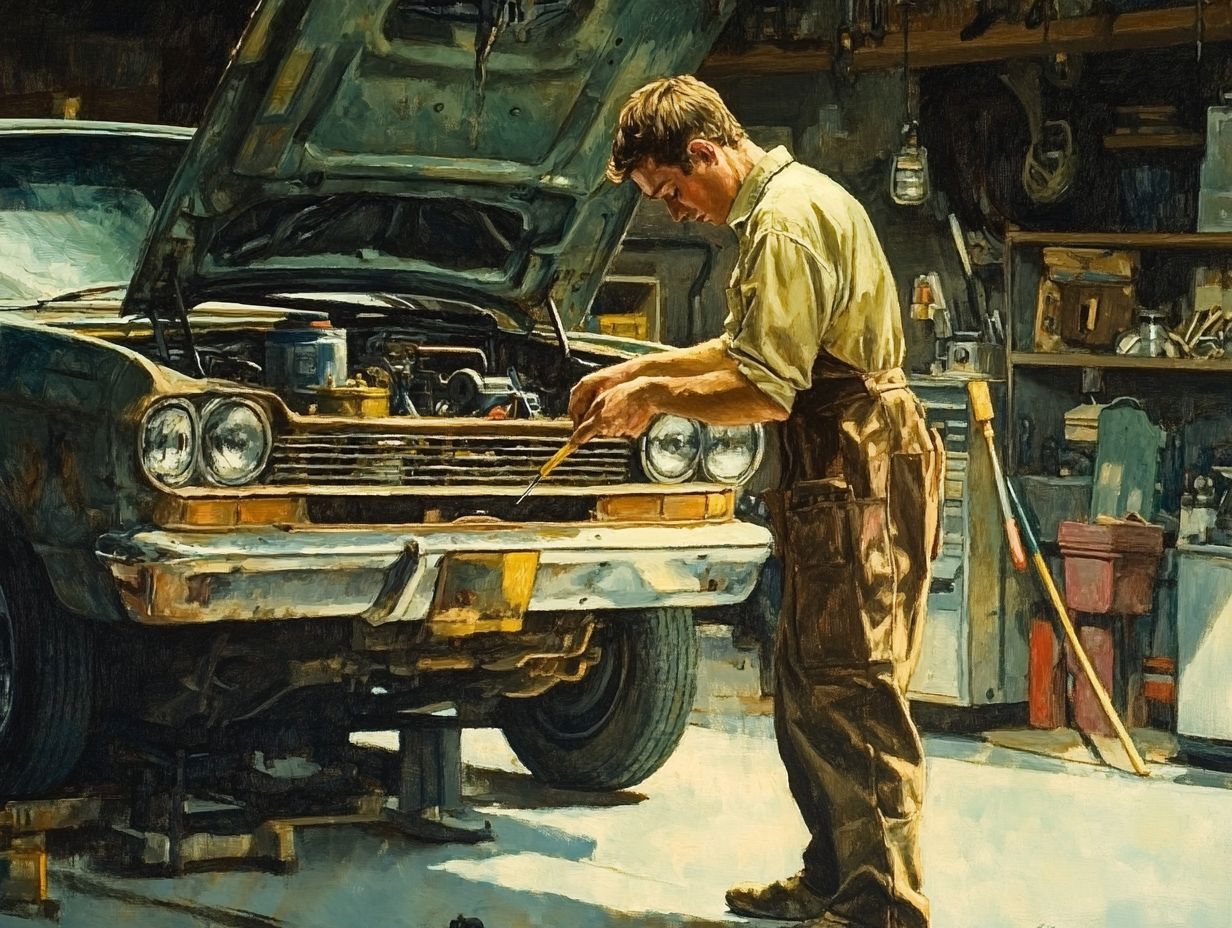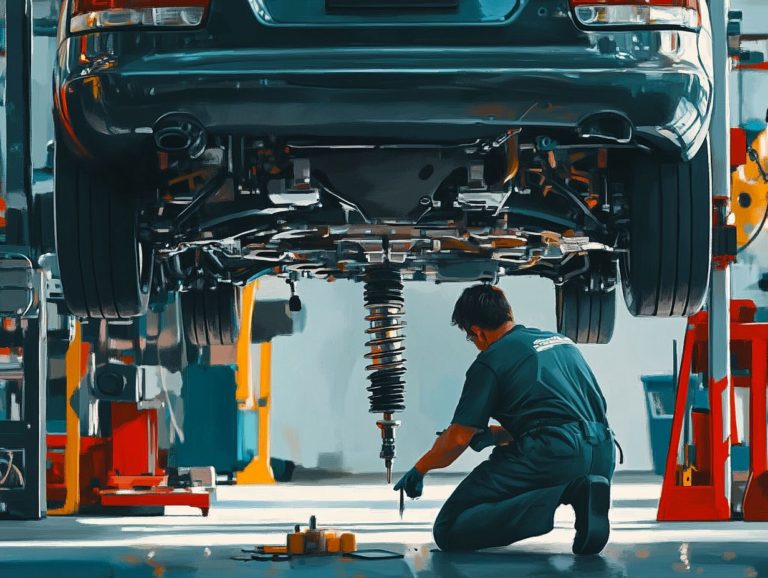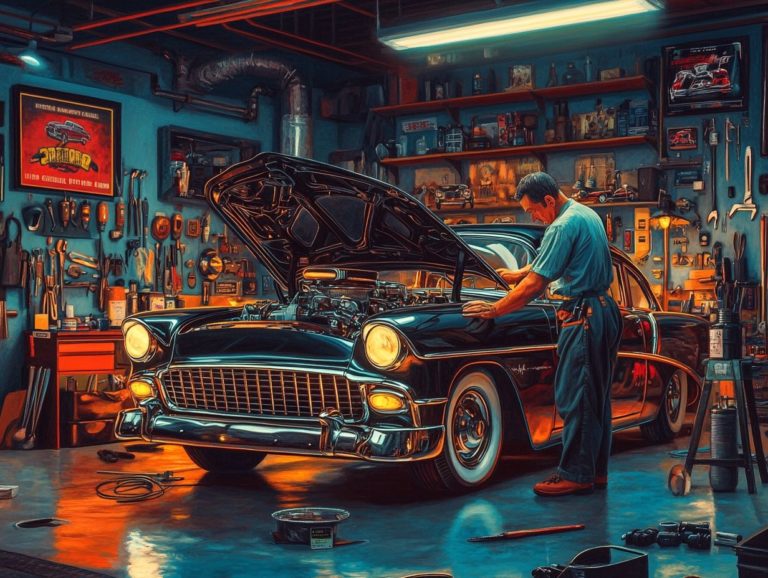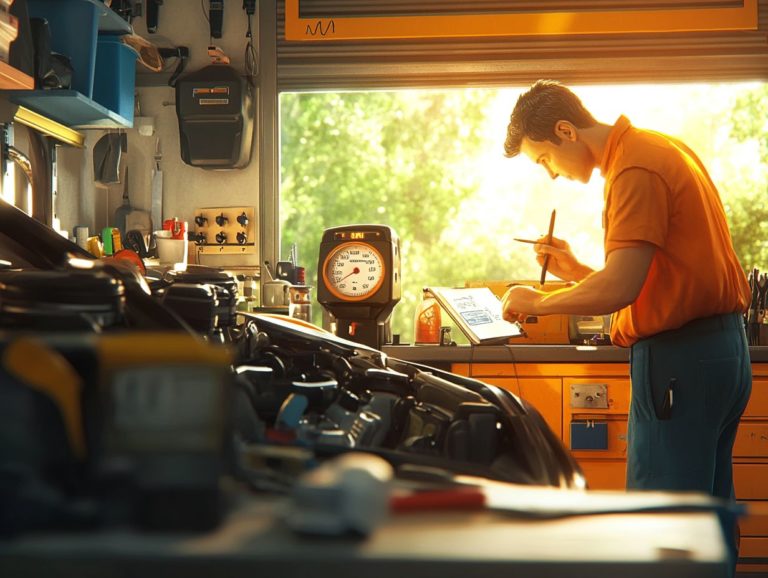DIY Car Maintenance: What You Can Do Yourself
Taking care of your car doesn t need to feel like a Herculean task meant only for the pros. Equipped with the right tools and a dash of know-how, you can confidently handle many maintenance tasks yourself, saving both time and money.
This article lays out the essential tools for DIY car maintenance, walks you through straightforward tasks like oil changes and tire rotations, and assists you in diagnosing common issues. Get ready to empower yourself and keep your vehicle running at its best!
Contents
- Key Takeaways:
- Benefits of Doing it Yourself
- Essential Tools for DIY Car Maintenance
- Regular Maintenance Tasks You Can Do Yourself
- Common Car Issues and How to Fix Them
- When to Seek Professional Help
- Signs of Complicated Issues
- Importance of Regular Check-Ups
- Frequently Asked Questions
- What is DIY car maintenance?
- Why should I learn how to do DIY car maintenance?
- What are some common DIY car maintenance tasks?
- Do I need any special equipment for DIY car maintenance?
- Are there any risks involved with DIY car maintenance?
- Do I still need to take my car to a mechanic for maintenance if I do DIY tasks?
Key Takeaways:

- Save money by learning to do basic car maintenance tasks yourself.
- Invest in essential tools for DIY car maintenance, such as an oil filter wrench and tire pressure gauge.
- Regularly performing simple maintenance tasks can prolong the life of your car.
Benefits of Doing it Yourself
Engaging in DIY car maintenance presents a wealth of advantages for you think cost savings, enhanced knowledge of your vehicle, and the satisfying feeling of accomplishing tasks on your own.
By familiarizing yourself with car maintenance, you ll gain the ability to tackle routine tasks like oil changes and tire rotations, honing your repair skills and decreasing your reliance on auto shops. Taking the DIY approach helps you understand your car better, enabling you to troubleshoot common issues and apply expert mechanic tips, ensuring that your vehicle runs like a dream.
Essential Tools for DIY Car Maintenance
Understanding the essential tools for DIY car maintenance is vital for effective and safe repairs. Whether you’re tackling a straightforward oil change, understanding dashboard warning lights, or swapping out headlights, having the right tools readily available enables you to approach various tasks with assurance.
Key items, such as a tire pressure gauge and a cordless power drill, become critical companions for any car enthusiast. With these tools at your disposal, you ll be well-equipped to check fluid levels or perform a radiator flush cleaning out your car’s cooling system with ease.
Must-Have Tools for Basic Maintenance
To effectively perform basic maintenance on your car, several essential tools should be part of your toolkit. These tools not only make tasks like checking oil levels or changing air filters a breeze but also equip you to handle emergencies, such as using jump cables to revive a battery when it needs a boost.
Familiarizing yourself with your car manual can elevate your maintenance game, helping you select the right engine coolant and execute essential tasks with ease. For instance, a reliable tire pressure gauge is critical for monitoring inflation, which is crucial for both safety and fuel efficiency.
Additionally, having a set of replacement wiper blades on hand is essential for maintaining clear visibility during rainy conditions, ensuring a safer drive overall. Keeping funnels and containers available for checking and topping up vital fluids like coolant, brake fluid, and windshield washer fluid ensures your vehicle runs smoothly.
With these tools at your disposal, you can effortlessly tackle routine checks, enhancing both the longevity and performance of your car.
Regular Maintenance Tasks You Can Do Yourself
Regular maintenance tasks are crucial for ensuring your vehicle remains in peak condition, and the good news is that many can be tackled on your own. Routine oil changes, tire rotations, and checks of essential fluids like wash fluid can not only save you money but also prolong the life of your car.
Knowing how to check your oil level and conduct safety inspections allows you to spot potential issues before they escalate into expensive repairs. This proactive approach will enhance your car maintenance skills and give you confidence in your vehicle s performance.
Oil Changes

Performing oil changes is one of the most essential maintenance tasks you can undertake to keep your engine running smoothly. Understanding how to change the engine oil and oil filter not only extends the life of your vehicle but also saves you money on repairs.
A maintenance checklist can guide you through the necessary steps: drain the old oil, replace the oil filter, and add fresh engine oil.
Choosing the right type of engine oil is crucial. It affects fuel efficiency and engine performance. Always consult your owner’s manual for recommendations on the oil’s thickness and brand.
When selecting an oil filter, ensure it meets the manufacturer s specifications. This filter helps keep impurities away from your engine.
If you enjoy doing it yourself, start with the right tools on a level surface. Establishing a regular maintenance schedule, perhaps every 3,000 to 5,000 miles, will keep your car performing well.
Act now to prevent costly repairs and enjoy a smoother, more enjoyable driving experience.
Tire Rotations
Regular tire rotations are essential for enhancing the longevity and performance of your tires. By rotating them based on size and pressure, you can ensure even wear and improve handling.
This task is straightforward and can be done at home with a few basic tools, saving you time and money while keeping your vehicle safe.
Understand that tire rotations should ideally be done every 5,000 to 7,500 miles. Always consult your vehicle’s manual for specific recommendations.
It’s equally important to check tire pressure before and after rotation. Keeping your tires properly inflated boosts fuel efficiency and enhances safety.
Incorporating tire rotations into a comprehensive maintenance routine alongside regular oil changes and brake checks ensures your vehicle stays in peak condition, extending its lifespan and reliability.
Battery Replacement
Understanding how to perform a battery replacement is crucial to avoid car troubles from a failing battery. Recognizing the signs of a weak battery allows you to jumpstart or replace it before getting stranded.
A battery tester makes the job easier. It helps you find the right replacement for your car model.
Once the tester shows that your battery is weak, gather your essential tools: gloves, safety goggles, and wrenches for a secure replacement.
Before removing the old battery, familiarize yourself with the jumpstart cables. Knowing how to use them properly can be a lifesaver.
As you prepare for the battery replacement, remember that safety is a priority. Disconnect the negative terminal before the positive to prevent short-circuits. Handle everything carefully to avoid risks from battery acid and electrical sparks.
Common Car Issues and How to Fix Them
Understanding common car issues and knowing how to fix them is essential for you as a DIY car owner. Whether troubleshooting that pesky check engine light or replacing worn-out parts like the engine air filter, mastering these skills can save you time and repair costs.
With access to comprehensive repair guides and tips from expert mechanics, you can confidently diagnose and tackle a range of car problems. This will enhance your skills as a DIY mechanic.
Replacing Spark Plugs
Replacing spark plugs is an uncomplicated yet impactful task that can greatly enhance your engine’s performance and fuel efficiency. Change your spark plugs regularly to keep your vehicle running at its best!
By following a few straightforward mechanic tips, you can easily access the spark plugs and identify when it’s time to replace them. This effectively prevents engine misfires and other potential issues. Regular replacements ensure smooth and efficient vehicle operation.
Begin by gathering essential tools, which typically include a spark plug socket, a ratchet, a gap tool (a tool used to measure the space between the spark plug electrodes), and a torque wrench. Before you start, inspect the spark plugs for any signs of wear, such as cracks or heavy carbon build-up these indicate it’s time for a change.
As you remove the old plugs, exercise caution to prevent debris from falling into the combustion chamber, which could lead to complications. Properly install the new plugs, ensuring they are gapped to the manufacturer s specifications. Well-maintained spark plugs play a vital role in fuel efficiency, directly influencing your vehicle’s power output and fuel consumption.
Changing Air Filters

Changing air filters can significantly improve your engine’s performance while ensuring clean air in your cabin. By regularly replacing both the engine air filter and cabin air filter, you enhance fuel efficiency and reduce harmful emissions. This straightforward task can often be accomplished with just a few basic tools, making it a perfect DIY project for car owners.
To determine when to change these filters, check your owner’s manual, which outlines the recommended intervals. Watch for signs of a clogged engine air filter, such as reduced engine power and increased fuel consumption. If your cabin filter needs replacing, you might notice unpleasant odors and diminished airflow.
To change the engine air filter, simply follow these steps:
- Locate the air intake box.
- Unscrew any fasteners.
- Replace the old filter with a new one.
For the cabin air filter, locate its housing usually behind the glove compartment and swap out the dirty filter. Clean air filters not only contribute to better engine performance but also enhance passenger comfort by ensuring a healthy environment within your vehicle.
Fixing a Flat Tire
Fixing a flat tire is an essential skill for any vehicle owner, saving you from frustration while ensuring your safety on the road. With just a few basic tools like a tire pressure gauge, a jack, and a lug wrench you can swiftly change a flat tire or make a repair if possible. Also, understanding how to properly inflate tires and maintain their pressure will help prevent future mishaps.
- Start by parking on a flat, stable surface and engaging the parking brake to keep everything secure.
- If your vehicle has hubcaps, remove them to expose the lug nuts, which should be loosened while the tire is still on the ground.
- Once those nuts are loose, use the jack to elevate the vehicle; just make sure you place it under the designated lift points for maximum stability.
- After replacing the flat tire with a spare, tighten the lug nuts securely in a star pattern for an even fit.
Regularly checking your tire pressure with the gauge will help maintain optimal levels, significantly reducing the risk of flats. If you ever doubt a repair, don t hesitate to seek professional assistance to avoid further damage.
When to Seek Professional Help
Understanding when to seek professional assistance is crucial for preserving both the longevity and efficiency of your vehicle. While many maintenance tasks can be tackled by DIY enthusiasts, specific indicators like persistent check engine light warnings or unusual noises should signal the need for a visit to a qualified mechanic.
Regular check-ups can uncover potential issues early on, allowing you to keep your car in peak condition, in line with your car manual recommendations.
Signs of Complicated Issues
Identifying signs of complicated issues is vital for ensuring timely intervention and effective repairs. Symptoms like a persistent check engine light, unusual fluctuations in engine temperature, or strange noises could point to underlying problems that require professional attention. By understanding these signs, you can consult mechanic tips and guides effectively, ensuring your vehicle receives the proper care it needs.
Noticing a decrease in fuel efficiency or having trouble accelerating can also signal issues that require prompt attention. Dashboard warnings can vary in severity; while some may seem minor, they can be early indicators of larger problems. For instance, alerts for low oil pressure or brake problems indicate issues that, if overlooked, could lead to safety hazards or costly repairs.
By recognizing these early indicators, you can make informed decisions about when to consult a professional mechanic, preserving your vehicle s performance and longevity.
Importance of Regular Check-Ups
Don t miss out on keeping your vehicle in top shape regular check-ups are key! They are essential for maintaining your vehicle’s performance and preventing costly repairs. By following a structured maintenance schedule, you can identify issues early, allowing for timely fixes that save you money and enhance your car’s longevity.
These inspections help maintain safety in key areas such as fluid levels, tire conditions, and brake functionality. By sticking to a consistent check-up routine, you adopt a proactive approach to car care, which leads to fewer emergency repairs down the road. This not only brings you peace of mind but also optimizes your vehicle s fuel efficiency and performance.
Over time, the financial benefits truly add up. Investing in regular maintenance is much easier than handling the hefty expenses that come with unexpected breakdowns or major repairs.
Watch this guide on DIY car maintenance tips!
Frequently Asked Questions

What is DIY car maintenance?
DIY car maintenance means you can tackle repairs yourself, saving time and money!
Why should I learn how to do DIY car maintenance?
Learning to perform DIY oil changes and other car maintenance tasks can save you money on expensive repairs and give you a better understanding of your vehicle’s inner workings.
What are some common DIY car maintenance tasks?
Some common DIY car maintenance tasks include changing the oil, replacing air filters, checking and replacing spark plugs, and changing tires.
Do I need any special equipment for DIY car maintenance?
Basic tools like a wrench, socket set, and jack are necessary for most DIY tasks. You may also need specific tools for certain jobs, such as an oil filter wrench.
Are there any risks involved with DIY car maintenance?
There may be some risks if you are unfamiliar with the process. It’s essential to follow instructions closely and take necessary safety precautions.
Do I still need to take my car to a mechanic for maintenance if I do DIY tasks?
While some maintenance tasks can be done on your own, it’s still crucial to have your car regularly checked by a professional mechanic. They can identify potential issues before they become significant problems.






